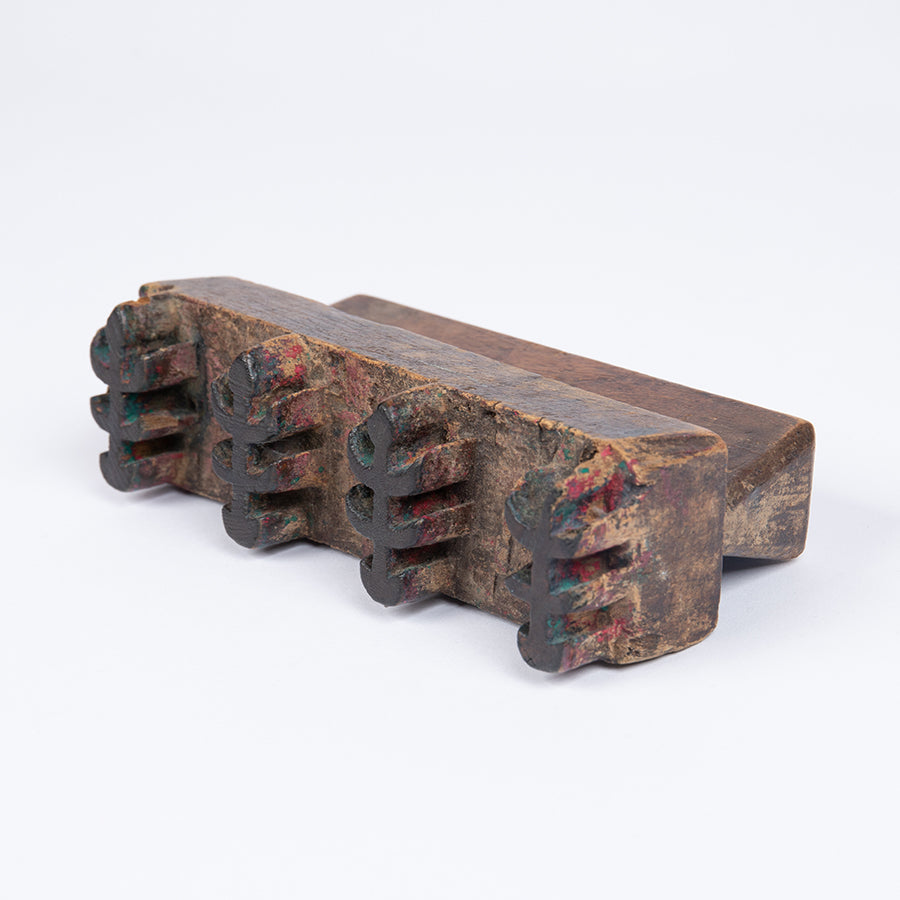Our original pattern, Kigi, is most striking with colorful patterns on off-white canvas.
One day, our boss, Shinzaburo, found something that looked much like a wood block used for printing at an antique shop.
It had four strange looking patterns like plants or fish bones.

This wood block had been used for batik, an Indonesian and Malaysian technique of wax-resist dyeing which originated in India.
Artisans draw the pattern by applying liquid wax on sections they do not wish to be dyed.

Shinzaburo "saw" this pattern as ‘trees’ which change color according to the seasons.
He decided to print the patterns on canvas at random like the plants growing in nature and dye them in the nine Japanese traditional colors of nature.

・Moss (Koke-iro)
The simple yet complex harmony of the greenish yellow of moss.
Venerable mossy trees and the subtlety of stone gardens are the epitome of beauty in Wabi-sabi.
・Ever-green (Tokiwa-iro)
The slightly brownish dark green color of evergreen pines and cedar.
Tokiwa means "unchanging" or "permanence" in Japanese.
・Light blue (Hanada-iro)
Hanada-iro is a color in aizome indigo dyeing.
Paler than indigo blue and deeper than pale green, it is recorded in The Chronicles of Japan or Engishiki, a book on the laws and customs of ancient Japan.

・Wine (Ebi-iro)
The dark burgundy such as that of the ripe berries of the crimson glory vine.
This color has been used as dye for ceremonial court dress and Japanese lady's robe by aristocrats of the Heian Period.
・Persimmon tannin (Kakishibu-iro)
The brown is made from the fermented juice of green persimmons.
Cloth or paper is dyed in the supernatant liquid to produce the distinctive brown.
Many years ago, Ichikawa Danjuro V (Kabuki actor, 1741-1806) loved this color so much so that he called it Danjuro-cha, and used it to dye his stage curtains.
・Flaxen (Ama-iro)
The yellowish light brown of flaxen yarn.
The off-white color of our linen canvas bag is this color.

・Dark red (Suou-iro)
The smoky red from the core of sappan wood growing in Southern India and the Malaysian Peninsula.
This color is familiar to Japanese people since early times as it can be seen used as coloring among the treasures of the Shosoin Repository.
・Russet (Akakuchiba-iro)
The brownish orange of the leaves which change color as autumn deepens.
This color appears in such Heian literature as The Tale of Genji and Kagero Diary.
・Mustard yellow (Kariyasu-iro)
The beautiful translucent yellow of silk dyed with kariyasu perennial grass.
It does not fade easily and is often used to produce a lovely green by mixing it with indigo blue.
The finished product is a spread of stately trees and Chinese character meaning bag on off-white canvas. The colors symbolize the changing seasons such as the fresh green of spring, the mature green of summer, the changing colors of autumn, the dry leaves of late autumn, and the snowcapped trees of winter.
Do enjoy each season together with Kigi, the seasonal colors of trees.
Do enjoy each season together with Kigi, the seasonal colors of trees.

Reference: Yoshioka Yukio, 2000. The Color Dictionary in Japan. Shikosha Publishing.


